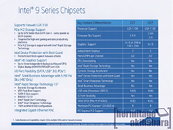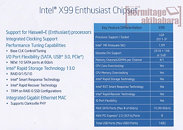Friday, March 28th 2014

Intel Finalizes Feature-sets of the First Wave of 9-series Chipsets
Here's what the first wave of Intel 9-series chipsets will look like. It will consist of upper-mainstream chipsets for the LGA1150 platform, and the sole chipset for the LGA2011-3 HEDT platform. LGA1150 will get two new chipsets based on a common silicon, the Z97 Express, and the H97 Express. The Z97 will be the next top-end chipset for the platform, supporting current Core "Haswell" and upcoming "Haswell refresh" and "Devil's Canyon" processors. Motherboards based on the Z97 chipset, like the ones based on the Z87 and Z77, will feature up to three PCI-Express 3.0 slots wired to the CPU, in configurations of x16/NC/NC, x8/x8/NC, and x8/x4/x4. It will support overclocking, something its sibling the H97 Express will lack. The H97 will also lack the PCIe configurations that the Z97 supports.
Both Z97 and H97 will introduce support for PCI-Express M.2 storage, which offers 66.6% higher bandwidth than SATA 6 Gb/s, and the same bandwidth as SATA-Express. Its introduction will spur up development and launches of a new generation of high-performance client SSDs in 2014-15. Apart from M.2, the two chipsets offer six SATA 6 Gb/s ports with AHCI and RAID support. Rapid Storage Technology (RST) and Smart Response Technology (SRT) are common for both chips, however, the Z97 also features Dynamic Storage Accelerator (DST), something the H97 will lack. H97 will exclusively offer Small Business Advantage (SBA), instead. Both chips will feature 8-lane PCI-Express gen 2.0 root complexes to drive onboard devices, and 14 USB ports, including six USB 3.0 SuperSpeed ports.The X99 Express is a different beast altogether. Designed for the upcoming "Haswell-E" HEDT platform, and the next-generation LGA2011-3 socket (incompatible with current LGA2011), the X99 platform is designed for high-end multi-GPU builds. It will let motherboard designers build boards with up to five PCI-Express 3.0 x16 slots wired to the CPU, in either x16/NC/x16/NC/x8, or x16/NC/x8/x8/x8, or even x8/x8/x8/x8/x8. Letting you toss in a screamingly fast PCIe SSD along with your 4-way multi-GPU setup. Intel appears to have gotten over the SATA+SAS mess it built with the previous X79/C608 common silicon, and gave the X99 a monolithic 10-port SATA 6 Gb/s storage controller, with RST and SRT support. SSD TRIM will be supported on RAID 0 configurations. An 8-lane PCI-Express gen 2.0 root complex drives onboard devices, just like the on the Z97/H97, and a 14-port USB controller, with 6 USB 3.0 ports completes its main feature-set. Intel plans to launch the three around Q2-Q3, 2014.
Source:
Hermitage Akihabara
Both Z97 and H97 will introduce support for PCI-Express M.2 storage, which offers 66.6% higher bandwidth than SATA 6 Gb/s, and the same bandwidth as SATA-Express. Its introduction will spur up development and launches of a new generation of high-performance client SSDs in 2014-15. Apart from M.2, the two chipsets offer six SATA 6 Gb/s ports with AHCI and RAID support. Rapid Storage Technology (RST) and Smart Response Technology (SRT) are common for both chips, however, the Z97 also features Dynamic Storage Accelerator (DST), something the H97 will lack. H97 will exclusively offer Small Business Advantage (SBA), instead. Both chips will feature 8-lane PCI-Express gen 2.0 root complexes to drive onboard devices, and 14 USB ports, including six USB 3.0 SuperSpeed ports.The X99 Express is a different beast altogether. Designed for the upcoming "Haswell-E" HEDT platform, and the next-generation LGA2011-3 socket (incompatible with current LGA2011), the X99 platform is designed for high-end multi-GPU builds. It will let motherboard designers build boards with up to five PCI-Express 3.0 x16 slots wired to the CPU, in either x16/NC/x16/NC/x8, or x16/NC/x8/x8/x8, or even x8/x8/x8/x8/x8. Letting you toss in a screamingly fast PCIe SSD along with your 4-way multi-GPU setup. Intel appears to have gotten over the SATA+SAS mess it built with the previous X79/C608 common silicon, and gave the X99 a monolithic 10-port SATA 6 Gb/s storage controller, with RST and SRT support. SSD TRIM will be supported on RAID 0 configurations. An 8-lane PCI-Express gen 2.0 root complex drives onboard devices, just like the on the Z97/H97, and a 14-port USB controller, with 6 USB 3.0 ports completes its main feature-set. Intel plans to launch the three around Q2-Q3, 2014.


55 Comments on Intel Finalizes Feature-sets of the First Wave of 9-series Chipsets
x99 & x79 use 2011 socket
Come on intel you just what more money their should be a why with a bios update intel could have made The Haswel-E to work with the X79.
Time to buy a new platform!!
With the pace of IPC or frequencies slowing compared to years back and the decent over clocking of the SB chips, there has been no need whatsoever to upgrade (whereas for example, gfx have changed).
X79 has been my best PC choice to date.
So two x16 cards and one x8. Or one x16 card and 3 x8. Or five x8 speeds. Does anyone know the reason why it's not possible with x16/x16/x16/x16/x16? What are the technological limitations that makes Intel go for this sort of set up? I've got x16/NC/x16/NC/x16/NC/x16 possibility on my MB today, or seven x8 single slots...
out of the box, intel does not support this. some boards get around this with the use of a PLX bridge, which is probably what your board has. this article is just talking about what the chipset itself can do, non-plx enhanced.
My X79 board has three USB 3.0 hubs tied to three PCI-E lanes off the PCH which works just as well as being integrated into the PCH or into the CPU (in the case of SoCs), and I too am using 16 lanes for both video cards (which is way more than enough.)
I find it hilarious that people complain about the PCH when they would barely utilize the full thing themselves despite its age, but still at least it has 40 PCI-E lanes so if there is ever a time when it isn't, I can still do what I want.
Saying X79 is slow because it's old is like saying my 2001 Saab 9-5 Aero is slow because it's old, despite the fact that it's turbo'ed and has at least 240HP (~180kW) worth of power. Tell me more about how @the54thvoid and my rig are slow and inadequate because of a PCH that's a few years old. Despite it's age, it's still more than enough for most consumers. Plus, DMI 2.0 only has so much bandwidth so Intel can only add so much until the PCH starts bottlenecking under certain workloads.It's what the CPU can do.* The CPU offers most of the PCI-E lanes, however both X79 and X99 will offer 8 individual PCI-E lanes for expansion.
For example, The P9X79 Deluxe fills up all of those PCI-E 1x lanes with features built into the board where two of which (the eSATA and wi-fi devices,) can be switched to use whatever is plugged into either PCI-E 1x slots in the board instead of the integrated devices.
The other thing was, most of my benchmarks were around the same, except for where the extra 2 cores come into play, and that's not often. then the X79 system was using almost twice the power. Memory latency was much slower on X79 and it just felt unresponsive to me. Then only 2 sata 6GB/s lack of native USB 3.0, the whole system just put me on a downer. Sure I could buy a bunch of add-in cards but that would only solve half the problems.
My haswell board has all the bells and whistles, I got the wifi, Bluetooth and Thunderbolt all 6GB/s and native USB 3.0, plus a bunch of cool new features from Asus.
I will be getting Haswell- E though, I prefer the HEDT platform, but only if its better than mainstream and this time it will be. Like having DDR4 memory, this is what people want, new technology and features, and something that is CLEARLY better than mainstream.
Chip looks bigger with Edram on it , package wise .
Bluetooth is slow(I haven't used it more than 5 times and that was on my laptop) Thunderbolt is expensive and only a few Z87 boards support it(and I don't even know what I'd use it for) and WiFi is only useful on PCs that move around a lot. If you use more than 3 SATA ports on Z87 to their maximum the others will not have enough bandwidth. Also the only use of SATA 3 is SSDs and few people will have more than 2 and if you do have more than 2 SSDs you should probably get a RAID card.
On some X79 boards you can have 2 GPUs a RAID card a Sound card and one more card all at the same time which is something no Z87 board is capable of doing.
X79 is meant to be the ultimate desktop chip set and should therefore be a system that stays in one place for most of it's life and has 3 or more expansion cards in it.
Just sayin'.
I too am waiting for Skylake and hope the corresponding Z97/Z107 platform include PCI-Express 4.0 x16 slots and NVLINK.
Tick Tick Tick (I didn't hear any Tock)
Also, chipset wise, he is right. 1366 only had one consumer chipset (X58), 2011 had only one (X79), and 2011-3 very well might only have X99, excluding server chipsets like the C600-series or 5500-series.